|
Enjoy the beautiful Midnight Sun & the bright nights! Visit Alaska and get a comprehensive look at Alaska's diverse flora, fauna and wilderness: join a glacier cruise through Kenai Fjords National Park and see orca whales, sea lions and giant calving tidewater glaciers up close, visit Talkeetna for a breathtaking flightseeing tour to 20,320 ft. Mt. Denali, enjoy unlimited hiking and grizzly bear viewing in Denali National Park, explore Alaska Last Frontier, Fairbanks and finally drive along the Trans-Alaska Pipeline and across the Yukon River to the Arctic Circle on one of the last great wilderness roads in North America - the magnificent "Dalton Highway". Experience 24 hours of uninterrupted daylight in Coldfoot - north of the Arctic Circle. We’ll be delighted to customize this driving tour just for you—whether you’re traveling solo, with your family, or with a group of friends. |
RRMC#04 Alaska Explorer & Arctic Circle | Motorcoach & Rail Tour
Tour Itinerary
Dates | Rates
Options | Extensions
Accommodation
Railroad FAQ
Denali National Park FAQ
|
Day
01 |
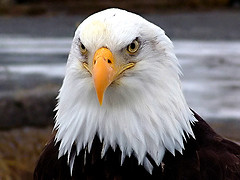 |
Anchorage Upon arrival in Anchorage, check in to your hotel in a prime downtown location. Get ready for a combined rail and motorcoach Alaska journey of a lifetime. Anchorage features dozens of parks and 122 miles of paved bike paths. Warmed by a maritime climate, you can spend the day salmon fishing at Ship Creek, hiking the nearby mountains, photographing glaciers and dining at a four-star restaurant. Within a 15-minute drive from downtown on the hillside is the tree-lined trailhead of Anchorage’s most popular hike, Flattop Mountain. A short floatplane ride opens up the possibility of almost any type adventure. That’s one reason why Anchorage’s Lake Hood is the world’s busiest floatplane base. Try some fresh Alaska seafood (Salmon, Halibut) for dinner in one of the many excellent restaurants around the hotel. Afterwards enjoy a stroll along the Tony Knowles Coastal Trail with sweeping views over the inlet to Mt. Denali and Mt. Susitna aka: "Sleeping Lady". Overnight: Anchorage |
|
Day
02 |
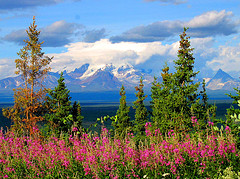 |
Anchorage - Seward | Rail Tour Board the legendary Alaska Railroad in Anchorage and depart for Seward at 6:45 AM. The tour offers incomparable vista of fjords, glaciers and mountains as you follow the Cook Inlet and Turnagain Arm, then climb steeply through the coastal mountains to cross Moose Pass. Arrive in Seward at 11.05 AM. Like many communities in Southcentral Alaska, Seward began a new era of history in 1964 after the Good Friday Earthquake caused fires and tidal waves that destroyed 90 percent of the town. One of the only reminders of the natural disaster is in the public library where the slide show covering the earthquake, “Waves Over Seward,” is shown. Visit the Exit Glacier just north of town. This road-accessible glacier offers an impressive up-close view of the glacier along with information and hiking trails. The more adventurous may take a guided kayak trip and spend the afternoon paddling among sea otters. Overnight: Seward |
|
Day
03 |
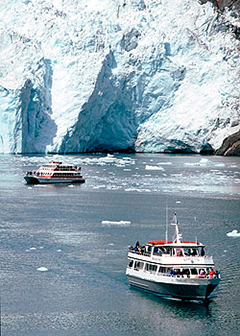 |
Seward | Kenai Fjords National Park The park covers an area of 669,984 acres (1,046.85 sq miles) on the Kenai Peninsula in southcentral Alaska. The park contains the Harding Icefield, one of the largest ice fields in the United States. Kenai Fjords National Park is named for the numerous fjords carved by glaciers moving down the mountains from the ice field. The field is the source of at least 38 glaciers, the largest of which is Bear Glacier. The park lies just to the west of Seward, a popular port for cruise ships. The remainder of the park is primarily accessible by boat. The fjords are glacial valleys that have been submerged below sea level by a combination of rising sea levels and land subsidence. Get ready for the full day narrated Kenai Fjords cruise (7 hrs) throughout the fascinating and beautiful Kenai Fjords National Park with abundant marine wildlife and massive tidewater glacier. The 120-mile cruise experience provides close-up views of two tidewater glaciers Holgate and Aialik Glaciers - the largest tidewater glaciers within the park which are actively "calving" glaciers and often massive chunks of ancient ice will plummet into the sea below. Get your camera ready and take pictures from a close distance ! Your cruise experience continues with a visit of the Chiswell Islands National Wildlife Refuge - an important marine bird sanctuary were millions of seabirds are nestling on nearly vertical islands. Last but not least, you see a small rookery of the endangered Steller Sea Lions. During the entire journey the experienced captain will host this cruise and provides information about the flora, fauna, geology and history of the park. He will also point out the many spectacular sights and provides answers on any questions you may have about the parks geology and wildlife. The tour provides some outstanding photo opportunities and the memories will last forever. Return to Seward and evening at leisure. Overnight: Seward. |
|
Day
04 |
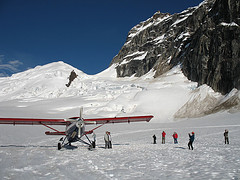 |
Seward - Talkeetna | Motorcoach Tour Board a comfortable motorcoach in Seward at 10:15 AM, stopover briefly in Anchorage and arrive around 5:30 PM in Talkeetna. Enjoy the views of snowcapped mountain ranges, pristine lakes, beautiful scenery and wildlife as you travel from Anchorage via Wasilla on the George Parks Highway to Talkeetna. Transfer to a downtown hotel or to a beautiful deluxe mountain lodge with breathtaking Alaska Range and Mt. Denali vistas. Remaining day at leisure in Talkeetna. Optional Tour: Take a flightseeing trip within 6-Miles of Denali's 20.320 ft summit and get a picture perfect view of the Kahiltna and Ruth Glacier with its Great Gorge - over 9.000 ft deep - as well as onto magnificent ice-falls. You will also see the Sheldon Amphitheatre - the largest of its kind in the world. During the tour you may catch also sights of mountain climbers attempting the "Great One". Another highlight will be an adventurous glacier landing. Overnight: Talkeetna |
|
Day
05 |
 |
Talkeetna - Denali National Park | Rail Tour Board the Alaska Railroad at the Talkeetna train station at 11:20 AM. Choose between the standard rail car or the glass-domed compartments with large panorama windows ensuring unobstructed views of the pristine scenery. Get the camera ready as the train crosses Hurricane Gulch Bridge, 300 feet above the creek. Arrival at Denali Village at 3:40 pm. Remaining day at leisure or for outdoor activities. Optional Denali Scenic Float Trip: Enjoy a scenic float trip near the entrance of Denali National Park with a taste of whitewater rafting. This guided trip skirts the boundaries of Denali National Park down the glacier-fed Nenana River. Experience beautiful scenery and keep your eyes out for moose, sheep, caribou and bear, as you raft downstream 11 miles. The most scenic portion of the Nenana River gives you a thrilling, yet safe rafting. More adventurous guests have the option to continue with the Canyon Run! Get into real whitewater rafting as you hang on through thrilling rapids. |
|
Day
06 |
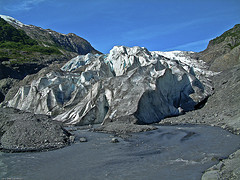 |
Denali National Park Denali National Park provides excellent wildlife viewing and spectacular sceneries. Pick up your pre-reserved tickets and get familiar with the exhibitions at the center if time allows. Options: upgrade to the Kantishna Wilderness Trails, or Tundra Wildlife Tour. Board the bus, sit back and watch out for grizzly bears, moose, caribou, wolf and fox moving along the ridges and river beds or observe one of the 150 different bird species which inherit the park area. Your driver informs you about the history of Denali National Park, its diverse wildlife and flora. Once a bear, caribou or another animal has been spotted the bus will stop that everyone can watch and take pictures. Your tour turns around at Eielson Visitor Center - 66 miles into the park. We can extend the bus tour to Wonder Lake or Kantishna Roadhouse. You can get off the bus anytime you wish and take a stroll, go hiking and enjoy the landscape. Return to the Denali Park entrance anytime during the day. Overnight: Denali National Park |
|
Day
07 |
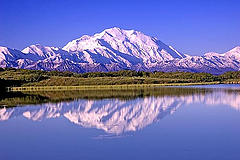 |
Denali National Park - Fairbanks | Rail Tour Morning at leisure: visit a park ranger sled dog introduction, raft or float on the Nenana River or take a scenic flightseeing tour around the Alaska Range and see Mt. Denali. Transfer to the Denali Rail Depot. Leave Denali at 4:00 PM for the scenic rail journey north towards Nenana - known for the Alaska Ice Classics. Arrival around 8:00 PM. Fairbanks, known as the Golden Heart City of Alaska, is the gateway to the interior and features almost 24 hours of daylight during the summer months. Only 120 miles from the Arctic Circle, Fairbanks offers excellent year-round outdoor recreational opportunities. Local points of interest include the Alaska University Museum with the best statewide natural history collection, the lively Alaskaland and the authentic 20-mile sternwheeler cruise on the Chena and Tanana Rivers. Overnight: Fairbanks. |
|
Day
08 |
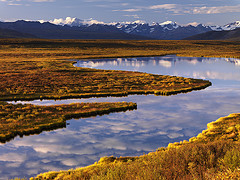 |
Fairbanks - Coldfoot (Arctic Circle) | Flight Fly from Fairbanks to Coldfoot - north of the Arctic Circle within the mighty Brooks Mountain Range. The flight provides an aerial view of the vast Alaska wilderness and the Alaska Pipeline. As Alaska’s visitors cross the Arctic Circle, legend has it that many pilots give the plane a slight “bump” letting passengers know they’ve crossed the legendary circle. Alaska’s Arctic is home to the Inupiat Eskimos, many who still live a subsistence lifestyle and still preserve their history verbally from generation to generation. The Far North is filled with a rich history and natural wonders, from the gold rush days of yore to the Gates of the Arctic. Optional: Koyokuk River Float - The North Fork of the Koyukuk flows south through a broad, glacially carved valley beside the Endicott Mountains in the Central Brooks Range. It is a clearwater river designated as " National Wild and Scenic River" and flows through dramatic peaks and through the "Gates of the Arctic" National Park. Overnight: Coldfoot |
|
Day
09 |
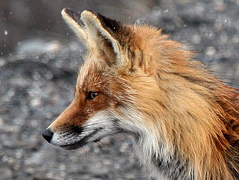 |
Coldfoot - Fairbanks | Van Tour Coldfoot is located roughly 174 miles into the 414-mile Dalton Highway. The Dalton Highway is often called the “Haul Road” because it’s mostly used by truckers en route from the oil fields of Prudhoe Bay to Fairbanks and points farther south. It has been made famous by the TV show “Ice Road Truckers,” and more people than ever are discovering its scenic beauty, wildlife and recreational opportunities. It is also one of Alaska’s most remote and challenging roads and it is mostly gravel. Cross the Arctic Circle and receive an official Arctic Circle Adventure Certificate. Explore up close the amazing arctic tundra and feel the veins of ice just beneath the surface as you travel along the Alaska Pipeline to the Yukon River and marvel at the majestic beauty of the northland's most famous waterway while learning of the river's storied past. Arrival in Fairbanks around midnight !! Overnight: Fairbanks |
|
Day
10 |
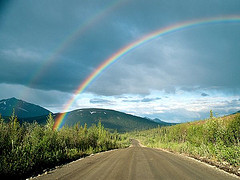 |
Fairbanks In 1902, Felix Pedro found gold in the region and thousands of prospectors swarmed to the area in search of the “Mother lode.” Nearly a century later, Fairbanks (population 32 000) is the trade and transportation center for Interior and Far North Alaska. From mid-May through July, visitors can enjoy more than 20 hours of sunlight a day. Today you have the unique chance to join an arctic flight to Alaska's vast, road-less interior. Tour ends. Optional: Extend the tour and drive along the Chena Hot Springs road (watch out for moose!), go on a hiking trip and visit Chena. Here you can relax in the large heated indoor pool or the natural outdoor rock lake. Visit the Aurora Ice Museum and grant yourself to a "Appletini" beverage served in an ice glass. |
| Rates in US $ / per Person | Single | Double | Triple | Quad | Child | |
| May 15 - May 31 | $4479.00 | $2945.00 | $2522.00 | $2286.00 | $560.00 | |
|
|
||||||
| June 1 - August 31 | $4622.00 | $3028.00 | $2575.00 | $2324.00 | $570.00 | |
|
|
||||||
| September 1 - September 20 | $4868.00 | $3284.00 | $2922.00 | $2686.00 | $560.00 | |
| Rates in US $ / per Person | Single | Double | Triple | Quad | Child | |
| May 15 - May 31 | $5560.00 | $3711.00 | $3187.00 | $2900.00 | $799.00 | |
|
|
||||||
| June 1 - August 31 | $6036.00 | $3949.00 | $3340.00 | $3010.00 | $836.00 | |
|
|
||||||
| September 1 - September 20 | $5949.00 | $4050.00 | $3587.00 | $3300.00 | $786.00 | |
| Daily Departures from May 15 - September 20 |
|
| Rates in US $ | per Person | Adult |
| Talkeetna: Mt. Denali Flightseeing Tour + $120 Optional Glacier Landing | |
| Exchange Shuttle Bus to 8-Hour Tundra Wilderness Tour including Boxed Lunch | |
| Exchange Shuttle Bus to Escorted 13-Hour Kantishna Wilderness Lodge / Backcountry Tour with Lunch, Interpretive Program, Gold Panning, En-route Refreshments Departure: 6:00 am / Return 7:00 pm |
|
| Coldfoot: Koyukuk River Scenic Float | |
| Coldfoot: Arctic Mountain Safari into Brooks Mountain Range | |
|
Superior Hotel Category (*** Hotels, Motels & Lodges) Superior Hotels offer a good amount of essential guest services and are located in downtown locations and/or in/near national park areas. All superior class hotel rooms are equipped with a private bathroom. Example larger hotel chains for superior class hotels are: Holiday Inn, Howard Johnson, Guesthouse Inn, Ramada Inn, High Country Inn, Aspen Hotel Group, Comfort Inn. As you might be aware, that these hotel chains are not available throughout Alaska. In such cases or/and when we feel that Alaskan owned hotels & lodges offer a better experience, we go with that choice. Cabins and Cottages also considered in this category to make your experience even more ‘Alaskan’. We ensure that all the Cabins & Cottages have a private bath to make your stay comfortable. 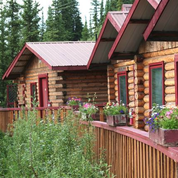 First Class Hotel Category (**** Hotels & Lodges) First Class hotels usually offer an additional amenities such as a restaurant, lounge, bar, fireplace seating, fitness room, swimming pool/hot tub, etc. All rooms in First Class hotels belong to a higher category and are always equipped with a private bathroom. Most hotels in this category are usually located in prime locations in prime downtown locations or in national parks. These include larger hotel chains such as: Marriott Hotels, Sheraton, Westmark Hotels, Princess Hotels and Lodges, Clarion Suites, Comfort Inn & Suite. The larger hotel chains are only available in Anchorage and Fairbanks. If a major hotel chain is not available, we prefer to book local premium hotels/deluxe cabins or cottages for our clients. Please note that premium accommodations may not be available in small towns; in such cases we will book the best available accommodation. 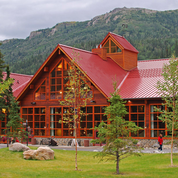 |
 |
| Alaska Rail Tour Services Regular Seating and Private Dome Car Choices Our Alaska Rail Tours are available with the following classes of service: Denali Star, Adventure Class Service | Many people prefer the standard class for its single level stability, generous seating and the ability to easily walk between different cars on the train. Gold Star Dome Cars Are the newest first-class rail cars in Alaska with large picture windows and fine dining options. Upper level dome car 360-degree viewing seating, priority check in, outdoor viewing deck. The lower level provides a restaurant, bar and gift shop. Midnight Sun Express Dome Cars | These 2-story dome cars with large multiple outside viewing platforms are operated by a private company. Enjoy the full-time 360-degree view dome seating with plenty of leg – and storage room. Additional features are: GPS assisted monitors, restaurant, bar and gift shop. The 1950’s Vintage Cars | The 1950's-era vintage railcars built by the well known Budd Company were some of the last reminders of the Golden Age of rail. A private company began acquiring Budd dome cars for passenger service on the McKinley Explorer train in Alaska. The seven cars the: Matanuska 508, Chena 509, Chulitna 510, Tanana 512, Talkeetna 513, Kashwitna 553 and Eklutna 554 were purchased and completely refurbished. These railcars were to become the most historic and elegant way to travel through America's Last Frontier. Mc.Kinley Explorer Dome Cars | Are the largest domed cars ever build with plenty of legroom, wide isles and additional luggage storage space. The seats are on the upper level – with restaurant, gift shop and bar downstairs - providing a 360-degree view through the glass windows around and the glass dome above you. All seats are wired so you may listen to music and recorded narration. GPS assisted monitors in each car are tracking the exact location. The covered outside viewing platform is a great feature for a breath of fresh air. All Alaska Rail Tours are including a pre-confirmed and assigned seat as well as on-board narration services. |
| Children Rate We provide a reduced tour rate for children up to 11 years. Please refer to each individual tour for more information. Children will be accommodated in parents room. |
| Dining The Midnight Sun Express, the McKinley Explorer and the Alaska Railroad Gold Star Dome Cars are offering full service breakfast, lunch and dinner options (all custom made to order) at the on-board restaurants. You will have the opportunity to visit the dining room and order freshly prepared food from the menu. Since all of our dishes are prepared to order we will do our best to accommodate all dietary concerns. Please notify us of any special dietary requirements at the time of reservation. Alcoholic beverages are also available. |
| Gratuities Recommended gratuities to the on-board train staff and host guides are $3.00 to $5.00 per person and day. Gratuities for meal and bar service are entirely discretionary, but 15% is customary in most Alaskan restaurants. All tipping is a matter of your individual preference and is of course - always voluntary. |
| Hotel Accommodation For additional information and addresses on hotels, lodges and resorts included in your railroad tour package, please check our „Info Center“ area. |
| Luggage Transfer & Access Passengers are limited to two pieces of checked baggage, not to exceed 50 pounds, that must be checked with the Alaska Railroad without charge. Each passenger may also take one carry on, not to exceed 2 ” by 14” by 17 ”, which will stored under your seat on the viewing level. Please pack any medications, cameras, binoculars or valuables in your carry-on. |
| Pets Are not allowed onboard (except assistance dogs) |
| Smoking Is not permitted on-board the trains. Smoking is allowed outside on the platforms. Ashtrays are available on the outside viewing platform. |
| Sightseeing Tours Most of our tours are including scheduled sightseeing trips. For more information please refer to each individual tour package. In addition to these scheduled tours we also provide a variety of exciting optional sightseeing trips with a great value. Please Note: Optional sightseeing tours are only available in connection with a confirmed rail tour package reservation. |
| Tickets & Travel Documents You’ll receive your boarding passes, travel documents and additional tour information on the departure day at the rail station. Ticketless travel options are available upon request. |
| Transfers Most scheduled transfers indicated within the itinerary are included in our rail tour packages. Optional pre/post hotel tour accommodation are including transfers from/to the airport. Private limousine and/or group coach transfers are available for an additional charge. |
| Wheelchair Access Each train has at least one rail car that this fully accessible to wheelchairs. A specially designed lift makes getting on and off the train easy and safe. There are also accessible restrooms on each of the accessible rail cars. |
| Alaska Rail Tour Travel Destinations Anchorage to Talkeetna | Anchorage is headquarters to the Alaska Railroad and the journey to Fairbanks begins here. Several miles into the trip, the heavy birch forests of Eagle River and Chugiak lead to the Knik and Matanuska Rivers.The expansive watershed harbors wildlife like moose, bear, the occasional wolf and abundant waterfowl. About 40 miles from Anchorage comes the Matanuska Valley, Alaska's agricultural center and home to the towns of Palmer and Wasilla. Just south of Talkeetna, 70 miles further, the first view emerges of Mt. Denali, North America's highest peak. The train takes its first stop in Talkeetna, a small town with a mining history and now, a popular takeoff point for climbers to Mt. Denali. Talkeetna to Denali | From Talkeetna, the track follows the serpentine banks of the Susitna River. On clear days, more views of Mt. Denali emerge across the river presenting many chances for photos. Black and brown bear frequent the sandbars and scuttle into the brush as the train approaches. Next, the Indian River Canyon is home to many beavers and beaver lodges can be seen in the ponds along the way. The track climbs toward tree line, first crossing Hurricane Gulch, the longest bridge on the railroad just over 914 feet and 296 feet above Hurricane Creek. The train moves into Broad Pass, at 2,363 feet it's the highest point on the railroad, and where caribou migrate through during the fall. Thousands of travelers visit Denali National Park and Preserve to see wildlife like wolves, caribou, Dall sheep, moose and bear, and, of course, Mt. Denali. Denali to Fairbanks | The coal-mining town of Healy follows after a 10-mile jaunt through Healy canyon, where the surging waters of the Nenana River cuts through the steep-sided cliffs. As the track levels out, Nenana comes into view. It is home to one of the remaining original Alaska Railroad Depots, now a museum and gift shop. The track cuts through the northern boreal forests of interior Alaska. Birch, aspen and willow fill this landscape where gold miners first came to seek their fortunes. Fifty-eight miles from Nenana, Fairbanks, the "Golden Heart City" signals the end of the line - but just the beginning for more adventure, culture and history in the Last Frontier. Seward to Anchorage | Your journey starts in Seward, the southern terminus of the railroad. It quickly begins its climb through primeval forests of Sitka spruce. After crossing Snowy River, Kenai Lake comes into view, set off with its stunning aqua color and surrounded by soaring mountains. Moose Pass - Thirty miles into the trip, the track winds through Moose Pass, a former railroad construction camp on the shores of Trail Lake. As the rail ascends into the Kenai Mountains, it leaves behind the forests and reveals mountain meadows and streams of gin-clear glacial waters. Trail Glacier appears on the right and soon after, the summit of Grandview at 1,063 feet and the historic Loop District - named for a complex series of trestles built to handle the steep grade in the age of steam engines. In the same stretch, Bartlett Glacier crowds the track just 800 feet away. Placer River Valley - After passing through a series of short tunnels, the track descends to the Placer River Valley near Spencer Glacier. Moose, bear and wolves populate the valley among the willow and alder trees. Trumpeter swans migrate through in spring and fall and arctic terns hover above the ponds and river looking for small fish and insects. Twelve miles later Turnagain Arm appears, where 40-foot tides rush into the narrow confines of the Chugach Mountains. Beluga whales pursue salmon and other schooling fish. Next comes Girdwood, home to Alaska's premier ski resort, a 40-mile commute from Anchorage. Chugach National Forest - The Chugach National Forest borders Turnagain Arm, some six million acres, the second largest in the U.S. Bald eagles cruise the thermals above and Dall Sheep come to feed on the low plants growing on the cliffs bordering the track. Next comes Potter Marsh in the Anchorage Coastal Wildlife Refuge. Anchorage is the final stop, 114 miles out of Seward. |
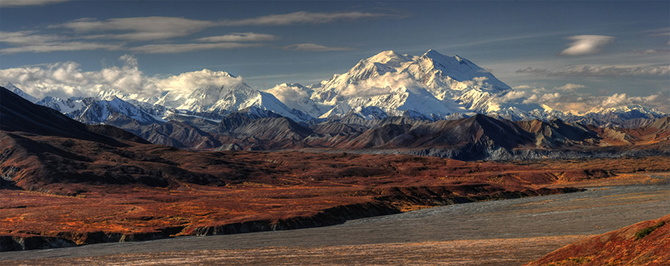 |
|||||||||||||||||||||||||||||||||||||||||||||||||||||||||||||||||||||||||||
FAQ | Denali National Park | formerly Mt.McKinley National Park
|
|||||||||||||||||||||||||||||||||||||||||||||||||||||||||||||||||||||||||||
